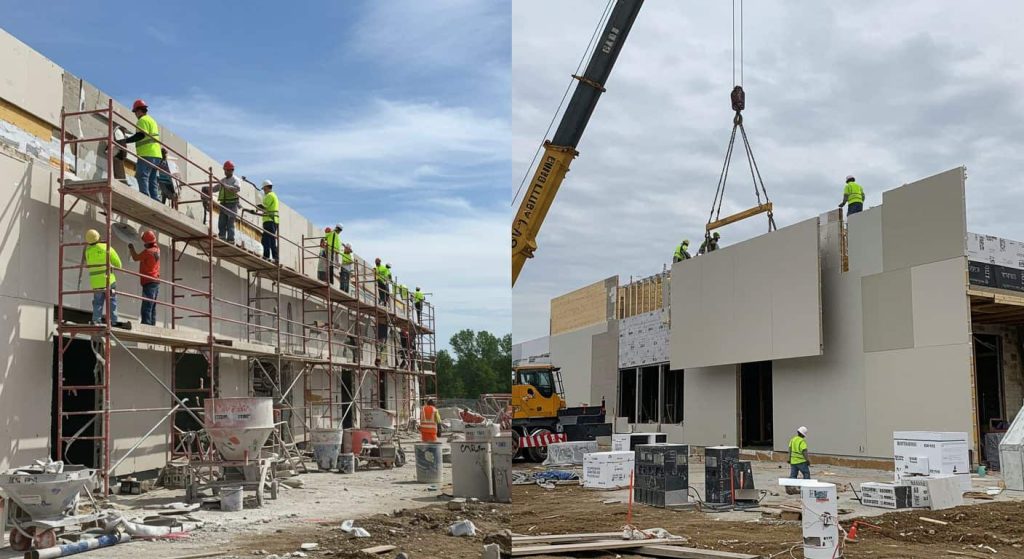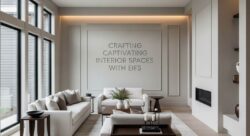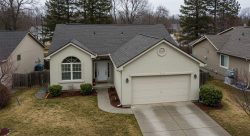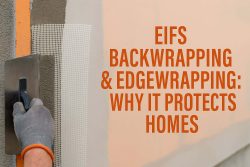Transform Project Timelines with Prebuilt EIFS Panels That Deliver Speed, Savings, and Superior Quality
The construction industry is changing fast. Projects need to be done quicker, costs need to stay low, and quality can’t suffer. That’s where EIFS panelization comes in as a game-changer for builders, contractors, and property owners.
Factory-built EIFS panels are changing how we think about exterior wall systems. Instead of building everything on-site, crews can install pre-made panels that cut installation time by up to 80%. This means faster project completion, lower labor costs, and better quality control.
As someone who’s been working with EIFS systems for over two decades, I’ve seen how prefabricated EIFS panels can transform a project timeline. The controlled factory environment means consistent quality. The reduced on-site work means fewer weather delays. And the simplified installation process means projects get done faster and safer.
Key Takeaways
- Factory-built EIFS panels reduce installation time by 60-80% compared to traditional field-applied systems
- Controlled manufacturing environments ensure consistent quality and eliminate weather-related delays during production
- Reduced labor costs come from simplified installation requiring fewer specialized workers
- Single-source warranties cover the entire panel system, reducing risk for contractors and owners
- Custom panel sizes and finishes provide design flexibility while maintaining speed advantages
What Is EIFS Panelization?
EIFS panelization takes the proven exterior insulation and finish system and moves most of the work from the construction site to a controlled factory setting. Instead of applying each layer on-site, manufacturers create complete prefabricated EIFS panels that arrive ready to install.
Think of it like the difference between building a car in your garage versus getting one from a factory. The factory version is faster, more consistent, and often higher quality because of the controlled environment and specialized equipment.

How Panelized EIFS Works
Factory-built EIFS panels combine all the traditional EIFS layers into one unit:
- Substrate backing (usually light-gauge metal or structural sheathing)
- Continuous insulation layer (typically EPS or mineral wool)
- Reinforcing mesh embedded in base coat
- Finish coat with desired color and texture
The panels get manufactured in climate-controlled facilities. Then they ship to the job site ready for installation. This off-site construction method eliminates most of the weather-dependent work that slows down traditional EIFS projects.
The Speed Advantage: Why Time Matters
Traditional EIFS installation requires multiple trades working in sequence. Each layer needs time to cure before the next one goes on. Weather can stop work for days. Panelized EIFS solutions change all that.
Installation Time Comparison: Traditional vs. Panelized EIFS
Traditional Field-Applied EIFS
Panelized EIFS
Traditional vs. Panelized Installation Timeline
Here’s what the numbers look like for a typical 10,000 square foot commercial project:
Traditional Field-Applied EIFS:
- Site preparation: 2-3 days
- Insulation board installation: 3-4 days
- Base coat application: 2-3 days
- Mesh embedding: 1-2 days
- Finish coat application: 2-3 days
- Weather delays: 3-7 days
- Total: 13-22 days
Panelized EIFS Installation:
- Site preparation: 1-2 days
- Panel installation: 2-3 days
- Sealant and finishing: 1-2 days
- Total: 4-7 days
That’s a reduction of 60-80% in installation time. For contractors, this means crews can move to the next job faster. For building owners, it means quicker return to business and earlier rental income.
Jeff Johnson from Indiana Wall Systems explains: “We’ve seen projects that would normally take three weeks get done in less than a week with panelized systems. That time savings translates directly to cost savings for our clients.”
Weather Independence
One of the biggest advantages of factory-built EIFS panels is that most of the work happens indoors. Traditional EIFS installation stops when it rains, snows, or gets too hot or cold. Panelized exterior insulation eliminates most weather-related delays.
The panels arrive at the job site already cured and ready to install. Installation can happen in light rain or cold weather that would shut down traditional EIFS work. This minimized weather delay factor alone can save weeks on a typical project schedule.
Cost Benefits That Add Up

Reduced installation time directly translates to lower costs across multiple categories. Here’s where the savings show up:
Labor Cost Reduction
Traditional EIFS requires specialized applicators for each layer. Panelized EIFS wall systems simplify installation so much that general construction crews can handle most of the work.
Labor savings include:
- Fewer specialized trade workers needed
- Shorter project duration reduces overall labor hours
- Reduced scaffolding costs from faster installation
- Less supervision time required
Material Efficiency
Factory-built wall panels eliminate material waste that’s common with field-applied systems. In a controlled factory setting, materials get used more efficiently. Leftover materials from one panel can go into the next one.
Optimized material usage also means:
- Precise material ordering (no over-ordering for waste allowance)
- Minimized material waste from weather damage
- Better inventory control and bulk purchasing power
- Reduced material handling and storage costs on-site
Indirect Cost Savings
The speed of panelized EIFS solutions creates savings beyond just labor and materials:
- Lower scaffolding costs from reduced rental time
- Faster project completion means earlier occupancy
- Reduced site security and management costs
- Lower insurance costs from shorter exposure periods
Quality Control: Factory vs. Field
Controlled factory environment manufacturing provides quality advantages that field application simply can’t match. Here’s why:
Consistent Conditions
Factory manufacturing means:
- Temperature control for optimal curing
- Humidity control for proper adhesion
- Clean environment free from dust and debris
- Precise material mixing and application
Quality Assurance Testing
Factory-built EIFS panels go through quality checks that aren’t possible on a construction site:
- Material testing before application
- Adhesion testing during production
- Thickness verification for all layers
- Visual inspection under controlled lighting
- Performance testing for completed panels
Key Benefits of Factory-Built EIFS Panels
60-80% Faster
Installation time dramatically reduced vs traditional methods
Superior Quality
Controlled factory environment ensures consistent results
Weather Independent
Minimal weather delays during installation
Improved Safety
Reduced high-work exposure and safer installation
Design Flexibility
Custom sizes, shapes, and finishes available
Single-Source Warranty
Comprehensive coverage for entire system
Skilled Technicians
Factory workers specialize in panelized EIFS production. They do the same process hundreds of times, developing expertise that traveling field crews can’t match. This specialization leads to consistent quality control across all panels.
Design Flexibility with Standardization
One concern about prefabricated EIFS panels is whether they limit design options. The reality is that modern panelization offers extensive customization while maintaining speed advantages.
Custom Panel Options
Factory-built wall panels can be manufactured in:
- Custom panel sizes up to shipping limitations
- Custom panel shapes for architectural features
- Custom panel finishes with unlimited color options
- Various insulation thicknesses for energy requirements
Architectural Features
Panelized exterior insulation can incorporate:
- Window and door openings
- Decorative elements and trim
- Curved surfaces and corners
- Integration with other building systems
Design Coordination
The factory environment allows for precise coordination between trades. Pre-engineered EIFS panels can include:
- Electrical conduit routing
- HVAC penetration planning
- Structural attachment points
- Flashing and drainage integration
Safety Improvements
Off-site fabricated EIFS dramatically improves job site safety by reducing the amount of work performed at height.
Reduced High-Work Exposure
Traditional EIFS installation requires workers to spend days or weeks on scaffolding applying multiple coats. Panelized EIFS solutions reduce this exposure by 70-80%.
Safety improvements include:
- Less time working at height
- Reduced need for scaffolding setup and breakdown
- Fewer material handling operations at elevation
- Simplified installation process reduces error potential
Controlled Manufacturing Environment
Factory workers operate in safer conditions:
- Stable work surfaces
- Proper ventilation systems
- Emergency equipment readily available
- Consistent safety protocols and training
Installation Process: Step by Step
Understanding how factory-built EIFS panels install helps contractors plan more effectively. Here’s the typical process:
Pre-Installation Planning
- Site survey and measurement verification
- Panel layout planning and sequencing
- Material delivery coordination
- Crew training on panel installation procedures
Panel Installation Sequence
- Substrate preparation and attachment point verification
- Panel positioning using lifting equipment
- Mechanical fastening to structural system
- Joint sealing between panels
- Final inspection and touch-up work
Panelized EIFS Installation Process
1. Site Preparation
Survey, measurement verification, and substrate preparation
1-2 Days2. Panel Installation
Position and mechanically fasten panels to structure
2-3 Days3. Finishing
Joint sealing, final inspection, and touch-up work
1-2 DaysTotal Installation Time: 4-7 Days
Quality Control During Installation
Even with pre-manufactured wall assemblies, proper installation remains critical:
- Verify panel alignment and level
- Check fastener spacing and penetration
- Inspect sealant application at joints
- Test system integrity before project completion
System Types and Applications
Panelized EIFS wall systems come in several configurations for different project types:
Load-Bearing vs. Curtain Wall Systems
Load-bearing EIFS panels integrate structural elements with the insulation system. These work well for:
- Single-story commercial buildings
- Residential construction
- Renovation projects with adequate structural support
Curtain wall EIFS panels attach to the building’s structural frame. These suit:
- Multi-story commercial buildings
- High-rise residential projects
- Buildings requiring superior wind load resistance
Barrier vs. Drainage Systems
Barrier EIFS panels rely on the finish system to keep water out. These work for:
- Single-story buildings
- Covered areas with limited weather exposure
- Budget-conscious projects
Drainage EIFS panels include water management features. These provide:
- Superior moisture protection
- Compliance with modern building codes
- Better long-term performance
Energy Efficiency Benefits
Continuous insulation in panelized systems provides superior thermal performance compared to traditional construction methods.
Thermal Bridge Elimination
Factory-built wall panels eliminate thermal bridges that occur with traditional framing methods. The continuous insulation layer covers the entire wall surface without interruption.
Improved Air Sealing
Panel joints get sealed during installation, creating a more airtight building envelope. This air barrier system integration improves:
- HVAC system efficiency
- Indoor comfort control
- Energy cost reduction
- Building durability
Performance Data
Studies show energy-efficient facade panels can reduce building energy consumption by 20-30% compared to traditional wall systems. The combination of continuous insulation and improved air sealing creates these savings.
Energy Efficiency Performance
Building Energy Consumption
Thermal Bridge Elimination
Continuous insulation prevents heat transfer through structural elements
Superior Air Sealing
Sealed panel joints create airtight building envelope
Project Applications
Panelized EIFS solutions work well for many project types:
Commercial Buildings
- Office buildings and medical facilities
- Retail centers and restaurants
- Warehouses and distribution centers
- Educational facilities
The speed advantage particularly benefits commercial projects where early occupancy drives revenue.
Residential Applications
- Multi-family housing developments
- Senior living facilities
- Student housing projects
- Single-family custom homes
Residential builders appreciate the predictable installation schedule and reduced weather delays.
Renovation Projects
Prefabricated exterior wall panels excel in renovation work because:
- Minimal disruption to occupied buildings
- Faster completion reduces business interruption
- Better quality control in challenging conditions
Common Challenges and Solutions
Like any construction method, EIFS panelization presents some challenges that proper planning can address:
Transportation and Handling
Large panel sizes require careful logistics planning:
- Truck routing for oversized loads
- Crane access for panel placement
- Storage area for panels awaiting installation
Joint Design and Sealing
Panel connections require careful attention:
- Proper sealant selection for joint movement
- Weather sealing during installation
- Long-term maintenance accessibility
Building Code Compliance
Prefabricated wall systems must meet all local building codes:
- Fire rating requirements
- Structural load calculations
- Energy code compliance verification
The Future of EIFS Panelization
The construction industry continues moving toward off-site construction methods. Several trends will shape factory-built EIFS panels development:
Automation and Robotics
Factory automation will improve:
- Production speed and consistency
- Quality control and testing
- Cost reduction through efficiency
Integration with Other Systems
Modular facade systems will increasingly integrate:
- Electrical and data systems
- HVAC components
- Renewable energy systems
- Smart building technology
Sustainability Focus
Environmental considerations drive development of:
- Recycled content materials
- Energy-efficient manufacturing processes
- End-of-life recycling programs
Making the Decision: When Panelized EIFS Makes Sense
Factory-built solutions aren’t right for every project. Here’s when they provide the most benefit:
Project Size Considerations
Panelized EIFS wall systems work best when:
- Project size justifies factory setup costs
- Repetitive panel designs allow economies of scale
- Schedule compression provides significant value
Budget Implications
While prefabricated EIFS panels may cost more upfront, total project costs often decrease due to:
- Reduced labor requirements
- Faster project completion
- Lower financing costs from shorter construction periods
Performance Requirements
Projects requiring superior quality control benefit most from factory manufacturing:
- High-visibility architectural projects
- Buildings with demanding performance requirements
- Projects in challenging weather conditions
Working with Panelized EIFS Manufacturers
Successful panelized EIFS projects require close coordination with manufacturers:
Design Development
Early manufacturer involvement helps:
- Optimize panel layouts for efficiency
- Coordinate with other building systems
- Ensure code compliance and performance
Quality Assurance
Reputable manufacturers provide:
- Factory quality inspections
- Material certifications and testing data
- Installation training and support
- Single-source warranty coverage
Installation Support
Good manufacturers offer:
- Installation crew training programs
- On-site technical support during installation
- Troubleshooting assistance for problems
Cost Analysis: Breaking Down the Numbers
Understanding the true cost of factory-built EIFS panels requires looking beyond just material prices. Here’s a comprehensive breakdown:
Direct Cost Comparison
For a typical 10,000 square foot commercial project:
Traditional Field-Applied EIFS:
- Materials: $45,000-$55,000
- Labor: $65,000-$85,000
- Equipment/scaffolding: $15,000-$20,000
- Total: $125,000-$160,000
Panelized EIFS System:
- Panel materials: $60,000-$75,000
- Installation labor: $25,000-$35,000
- Equipment/crane: $8,000-$12,000
- Total: $93,000-$122,000
Indirect Savings
Accelerated project timeline creates additional value:
- Reduced financing costs from shorter construction loans
- Earlier rental income or business operations
- Lower general contractor overhead costs
- Reduced site management and security costs
Long-Term Value
Quality-assured EIFS panels often provide better long-term value:
- Consistent quality control reduces maintenance needs
- Factory warranties cover entire system performance
- Better energy efficiency reduces operating costs
Cost Comparison: 10,000 sq ft Commercial Project
Traditional Field-Applied EIFS
Panelized EIFS System
Potential Savings: $32,000-$38,000 Up to 24% Cost Reduction
Regional Considerations for Indiana Projects
Indiana’s climate presents specific challenges that panelized EIFS solutions address effectively:
Weather Patterns
Indiana’s variable weather makes minimized weather delays particularly valuable:
- Spring rain seasons can halt traditional EIFS work
- Winter freezing prevents proper curing
- Summer heat stress affects material performance
Factory-built panels eliminate most weather sensitivity during the critical installation period.
Local Building Codes
Indiana building codes increasingly emphasize:
- Continuous insulation requirements for energy efficiency
- Air barrier system compliance for moisture control
- Structural performance for wind loads
Pre-engineered EIFS panels help ensure code compliance through factory testing and quality control.
Labor Market
Central Indiana’s construction labor market benefits from reduced specialized labor requirements:
- Growing demand for EIFS installers exceeds supply
- General workforce installation capability expands contractor options
- Faster installation reduces labor scheduling conflicts
Manufacturer Selection Criteria
Choosing the right EIFS panel manufacturer significantly impacts project success. Key factors include:
Technical Capabilities
Look for manufacturers offering:
- Custom panel sizes and configurations
- Multiple insulation and finish options
- Integration with other building systems
- Testing and certification compliance
Quality Systems
Reliable manufacturers provide:
- ISO certification or equivalent quality systems
- Regular third-party testing and verification
- Comprehensive quality control documentation
- Factory quality inspections with detailed reports
Support Services
Strong manufacturer support includes:
- Design assistance and technical consulting
- Installation training programs
- Field technical support during installation
- Warranty service and maintenance programs
Installation Training and Certification
While panelized EIFS solutions simplify installation, proper training remains essential:
Manufacturer Training Programs
Most EIFS panel manufacturers offer:
- Installation technique certification
- Safety procedure training
- Quality control verification methods
- Troubleshooting and repair procedures
Contractor Certification Benefits
Certified contractors typically receive:
- Extended warranty coverage options
- Priority technical support access
- Marketing support and referrals
- Access to advanced products and systems
Ongoing Education
The panelized exterior insulation industry continues evolving. Successful contractors invest in:
- Annual training updates
- New product education
- Code change seminars
- Best practices sharing with other contractors
Warranty and Performance Guarantees
Single-source warranty coverage represents a major advantage of factory-built EIFS panels:
Comprehensive Coverage
Panel manufacturers typically warrant:
- Material performance for 10-15 years
- Labor defects for 2-5 years
- System performance against water intrusion
- Thermal performance guarantees
Warranty Transfer Benefits
Transferable warranties add value for building owners:
- Increased resale value
- Reduced buyer concerns about system performance
- Marketing advantage for commercial properties
Maintenance Requirements
Warranty compliance typically requires:
- Regular inspection and maintenance
- Prompt repair of damage or wear
- Use of approved materials for repairs
- Documentation of maintenance activities
Environmental Impact and Sustainability
Off-site construction methods often provide environmental benefits compared to traditional field construction:
Reduced Waste
Controlled-environment manufacturing minimizes waste through:
- Precise material usage calculations
- Recycling of production waste
- Optimized material usage across multiple panels
Energy Efficiency
Factory-built wall panels improve building performance:
- Superior insulation continuity
- Better air sealing performance
- Reduced thermal bridging
- Lower long-term energy consumption
Transportation Considerations
Prefabricated exterior wall panels require careful transportation planning:
- Consolidate shipments to reduce truck trips
- Use fuel-efficient transportation methods
- Plan delivery schedules to minimize storage time
Frequently Asked Questions
What is EIFS panelization and how does it work?
EIFS panelization is a construction method where exterior insulation and finish system components are assembled in a factory setting rather than on-site. Complete wall panels arrive ready for installation, dramatically reducing construction time and improving quality control.
How much faster is panelized EIFS installation compared to traditional methods?
Factory-built EIFS panels typically reduce installation time by 60-80% compared to traditional field-applied systems. A project that might take three weeks with conventional methods can often be completed in less than a week with panelized systems.
Are panelized EIFS systems more expensive than traditional installation?
While prefabricated EIFS panels may have higher upfront material costs, total project costs often decrease due to reduced labor requirements, faster completion times, and fewer weather-related delays. The time savings frequently offset any material cost increases.
Can panelized EIFS accommodate custom designs and architectural features?
Modern factory-built wall panels offer extensive customization options including custom sizes, shapes, colors, and textures. Manufacturers can incorporate architectural details, window openings, and decorative elements while maintaining the speed advantages of panelization.
What quality control advantages do factory-built panels provide?
Controlled factory environments enable consistent temperature, humidity, and cleanliness during manufacturing. This results in superior adhesion, proper curing, and consistent finish quality that’s difficult to achieve in field conditions.
Do panelized EIFS systems meet building code requirements?
Pre-engineered EIFS panels are designed to meet or exceed local building codes. Factory testing and quality control help ensure compliance with fire ratings, structural requirements, and energy codes before panels reach the job site.
What types of buildings benefit most from panelized EIFS?
Panelized EIFS solutions work well for commercial buildings, multi-family residential projects, and renovation work where schedule compression provides significant value. Projects with repetitive panel designs and larger square footage typically see the greatest benefits.
How do weather conditions affect panelized EIFS installation?
Factory-built panels arrive fully cured and ready to install, making them much less sensitive to weather conditions than traditional EIFS installation. Light rain or cold weather that would stop conventional work typically won’t delay panel installation.
What warranty coverage comes with panelized EIFS systems?
Most manufacturers provide single-source warranties covering both materials and system performance for 10-15 years. This comprehensive coverage often includes protection against water intrusion and thermal performance guarantees.
How do I select the right panelized EIFS manufacturer?
Look for manufacturers with proven track records, comprehensive quality systems, custom fabrication capabilities, and strong technical support programs. Factory quality inspections, certification programs, and warranty coverage should all factor into your selection decision.
Making EIFS Panelization Work for Your Project
Factory-built EIFS panels represent a significant advancement in exterior wall construction. The combination of speed, quality, and cost-effectiveness makes panelized EIFS solutions an attractive option for many project types.
The key to success lies in early planning and manufacturer selection. Projects that benefit most from prefabricated exterior wall panels typically have:
- Tight construction schedules requiring fast installation
- Quality requirements demanding consistent finish appearance
- Weather exposure that could delay traditional installation
- Budget constraints benefiting from reduced labor costs
As the construction industry continues evolving toward off-site construction methods, EIFS panelization will likely become more common. Building owners and contractors who understand and utilize these systems will have competitive advantages in completing projects faster, better, and more cost-effectively.
For projects in central Indiana where weather delays and skilled labor availability create challenges, factory-built solutions offer particular advantages. The controlled manufacturing environment and simplified installation process help ensure projects stay on schedule regardless of external conditions.
Whether you’re considering panelized EIFS wall systems for a new construction project or exploring options for property renovations, the speed and quality advantages make this technology worth serious consideration. The future of EIFS installation is moving toward the factory, and projects that embrace this change will reap the benefits of faster, safer, and more efficient construction.
For expert guidance on whether EIFS panelization makes sense for your specific project, contact Indiana Wall Systems at (765) 341-6020. Our team can help evaluate your requirements and connect you with appropriate EIFS installation solutions that meet your timeline, budget, and quality expectations.
Remember, in today’s competitive construction environment, the fastest path to quality results often runs through the factory floor, not just the construction site.





